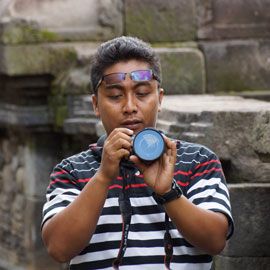Dieng
Plateau is a marshy plateau that forms the floor of a caldera complex on
the Dieng Volcanic Complex near Wonosobo, Central Java, Indonesia.
Referred to as "Dieng" by Indonesians, it sits at 2,000 metres (6,600
ft) above sea level, far from major population centres. The name "Dieng"
comes from Di Hyang which means "Abode of the Gods". Part of General
Sudirman's guerrilla campaign during the Indonesian War of Independence
took place in the area.

The Plateau is the location eight small Hindu temples. It is unclear
when they were built, estimated to range from mid 7th century to end of
8th century AD; they are the oldest known standing stone structures in
Java They are originally thought to have numbered 400 but only eight
remain. The temples are now believed to have been named after the heroes
of the Hindu epic Mahabharata. Michell claims Dieng's misty location
almost 2,093 m above sea level, its poisonous effusions and
sulphur-coloured lakes make it a particularly auspicious place for
religious tribute. The temples are small shrines built as monuments to
the god-ancestors and dedicated to Shiva. The Hindu shrines are
miniature cosmic mountains based on plans in Indian religious texts,
although Schoppert suggest the design motifs have little connection to
India. In 2011, in a review published by Romain, the temple is now
believed to be related to Dravida and Pallava style temples of South
India. The theory that poisonous effusions make it auspicious is now
disputed as volcanic activity in this area from 7th to 9th century is
yet to established, and records suggest the temple was abandoned after
volcanic eruptions became common in central Java.
-source : wikipedia-
Goa Pindul attractions such as caves are located in the village Bejiharjo, District Karangmojo, Gunungkidul. Pindul known because of the way down the cave is done by climbing on top of the tube underground river in the cave, this activity is known as cave tubing. Underground river starts from the mouth of the cave until the end of the cave, inside the cave there is a narrow passage that only passable one the tube, so that tourists usually take turns one by one to skip this section. The length of the cave is 350 meters Pindul with a width of 5 meters and the distance to the water surface of the roof of the cave 4 meters. Caving Pindul takes approximately one hour that ends at a dam. River flow inside Pindul comes from springs gedong Seven. Tourist attraction Pindul inaugurated on October 10, 2010.
source : wikipedia

Mount Merapi, Gunung Merapi (literally Fire Mountain in Indonesian/Javanese), is an active stratovolcano located on the border between Central Java and Yogyakarta, Indonesia. It is the most active volcano in Indonesia and has erupted regularly since 1548. It is located approximately 28 kilometres (17 mi) north of the large Yogyakarta city, and thousands of people live on the flanks of the volcano, with villages as high as 1,700 metres (5,600 ft) above sea level. Smoke can be seen emerging from the mountaintop at least 300 days a year, and several eruptions have caused fatalities. Pyroclastic flow from a large explosion killed 27 people on 22 November 1994, mostly in the town of Muntilan, west of the volcano. Another large eruption occurred in 2006, shortly before the Yogyakarta earthquake. In light of the hazards that Merapi poses to populated areas, it has been designated as one of the Decade Volcanoes. On 25 October 2010 the Indonesian government raised the alert for Mount Merapi to its highest level and warned villagers in threatened areas to move to safer ground. People living within a 20 km (12 mi) zone were told to evacuate. Officials said about 500 volcanic earthquakes had been recorded on the mountain over the weekend of 23–24 October, and that the magma had risen to about 1 kilometre (3,300 ft) below the surface due to the seismic activity. On the afternoon of 25 October 2010 Mount Merapi erupted lava from its southern and southeastern slopes. The mountain was still erupting on 30 November 2010, however due to lowered eruptive activity on 3 December 2010 the official alert status was reduced to level 3. The volcano is now 2930 metres high, 38 metres lower than before the 2010 eruptions. After a large eruption in 2010 the characteristic of Mount Merapi was changed. On November 18, 2013 Mount Merapi burst smoke up to 2,000 meters high, one of its first major phreatic eruptions after the 2010 eruption. Researchers said that this eruption occurred due to combined effect of hot volcanic gases and abundant rainfall.
-source : wikipedia-
Candi Prambanan or Candi Rara Jonggrang is a 9th-century Hindu temple compound in Central Java, Indonesia, dedicated to the Trimurti, the expression of God as the Creator (Brahma), the Preserver (Vishnu) and the Destroyer (Shiva). The temple compound is located approximately 17 kilometres (11 mi) northeast of the city of Yogyakarta on the boundary between Central Java and Yogyakarta provinces. The temple compound, a UNESCO World Heritage Site, is the largest Hindu temple site in Indonesia, and one of the biggest in Southeast Asia. It is characterized by its tall and pointed architecture, typical of Hindu temple architecture, and by the towering 47-metre-high (154 ft) central building inside a large complex of individual temples. Prambanan attracts many visitors from across the world.
Borobudur, or Barabudur, is a 9th-century Mahayana Buddhist Temple in Magelang, Central Java, Indonesia. The monument consists of six square platforms topped by three circular platforms and is decorated with 2,672 relief panels and 504 Buddha statues. A main dome, located at the center of the top platform, is surrounded by 72 Buddha statues each of which is seated inside a perforated stupa. It is the world’s largest Buddhist temple, as well as one of the greatest Buddhist monuments in the world.





















